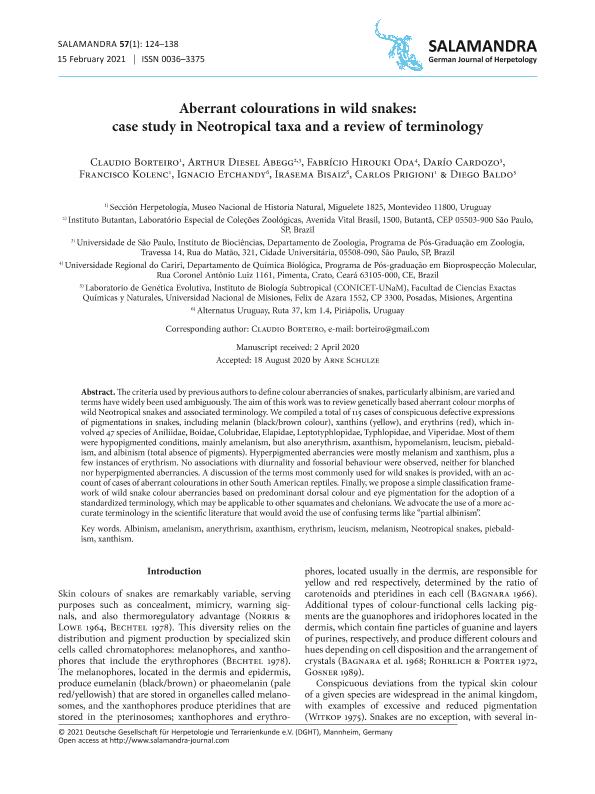Artículo
Aberrant colouration in wild snakes: case study in Neotropical taxa and a review of terminology
Borteiro, Claudio; Diesel Abegg, Arthur; Hirouki Oda, Fabrício; Cardozo, Dario Elbio ; Kolenc, Francisco; Etchandy, Ignacio; Bisaiz, Irasema; Prigioni, Carlos; Baldo, Juan Diego
; Kolenc, Francisco; Etchandy, Ignacio; Bisaiz, Irasema; Prigioni, Carlos; Baldo, Juan Diego
 ; Kolenc, Francisco; Etchandy, Ignacio; Bisaiz, Irasema; Prigioni, Carlos; Baldo, Juan Diego
; Kolenc, Francisco; Etchandy, Ignacio; Bisaiz, Irasema; Prigioni, Carlos; Baldo, Juan Diego
Fecha de publicación:
02/2021
Editorial:
Deutsche Gesellschaft für Herpetologie und Terrarienkunde
Revista:
Salamandra
ISSN:
0036-3375
Idioma:
Inglés
Tipo de recurso:
Artículo publicado
Clasificación temática:
Resumen
The criteria used by previous authors to define colour aberrancies of snakes, particularly albinism, are varied and terms were usually used ambiguously. The aim of this work was to review genetically based aberrant colour morphs of wild Neotropical snakes and associated terminology. We compiled a total of 115 cases of conspicuous defective expression of pigments in snakes, including melanin (black/brown colour), xanthins (yellow), and erythrins (red), which involved 47 species of Aniliidae, Boidae, Colubridae, Elapidae, Leptotyphlopidae, Typhlopidae, and Viperidae. Most of them were hypopigmented conditions, mainly amelanism, but also anerythrism, axanthism,hypomelanism, leucism, piebaldism, and albinism (total absence of pigments). Hyperpigmented aberrancies were mostly melanism and xanthism, plus a few instances of erythrism. No associations with diurnality and fossorial behaviour were observed, neither for blanched nor hyperpigmented aberrancies. A discussion of terms most used for wild snakes is provided, with an account of cases of aberrant colouration in other South American reptiles. Finally, we propose a simple classification framework of wild snake colour aberrancies based on dorsal main colour and eye pigmentation for the adoption of a standardized terminology, that may be applicable to other squamates and turtles. We claim for a more accurate terminology in the scientific literature, that would avoid the use of confusing terms like partial albinism.
Archivos asociados
Licencia
Identificadores
Colecciones
Articulos(IBS)
Articulos de INSTITUTO DE BIOLOGIA SUBTROPICAL
Articulos de INSTITUTO DE BIOLOGIA SUBTROPICAL
Citación
Borteiro, Claudio; Diesel Abegg, Arthur ; Hirouki Oda, Fabrício ; Cardozo, Dario Elbio; Kolenc, Francisco; et al.; Aberrant colouration in wild snakes: case study in Neotropical taxa and a review of terminology; Deutsche Gesellschaft für Herpetologie und Terrarienkunde; Salamandra; 57; 2-2021; 124-138
Compartir



